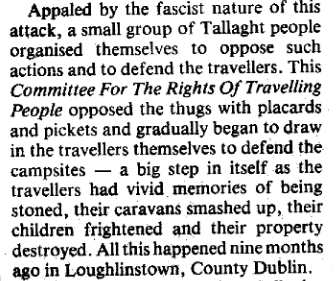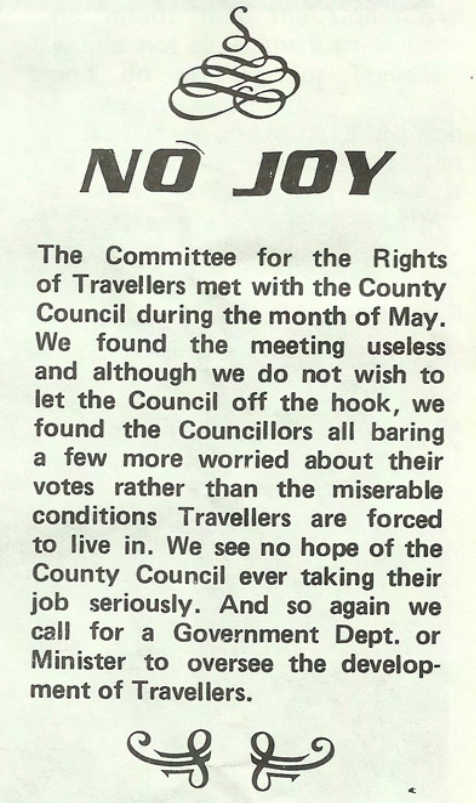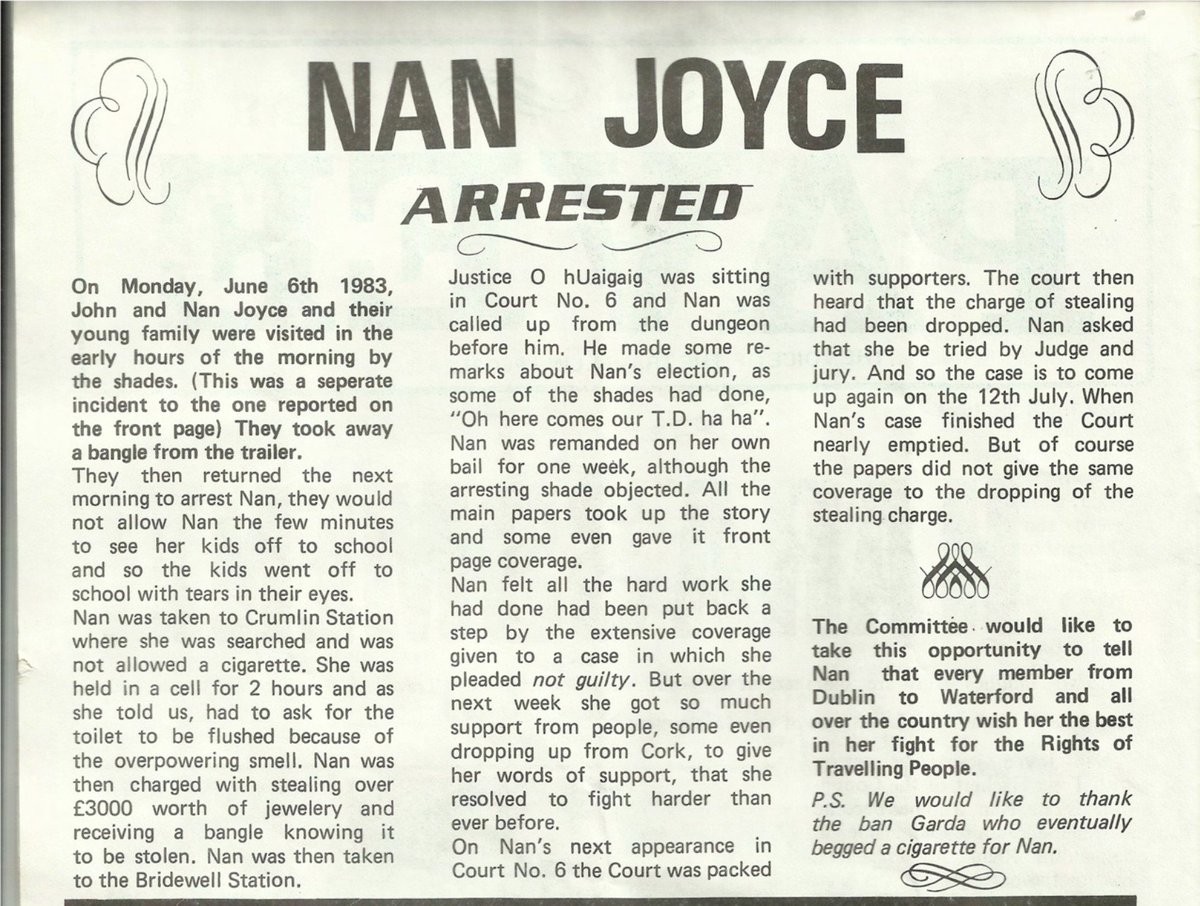Traveller Activism in the 1980s: The Committee for the Rights of Travellers and Mincéir Misli Commentary from Aonrud

12th July 2022
The Committee for the Rights of Travellers was formed in 1982 in response to anti-Traveller protests in Dublin with the aim of exposing mistreatment of Travellers by the state and anti-Traveller protesters, and making the case for Traveller ethnicity (which was ultimately formally recognised by the state in 2017).
It included members of Traveller and settled communities, but later became the Traveller-only group, Mincéir Misli, which appears to have been defunct by 19851.
Background
The 1963 “Report of the Commission on Itineracy”2 (which had been established by the state in 1960) illustrates the state attitude to Irish Travellers at that time and in the following decades: its terms of reference include recommendations to “promote their [Travellers] absorption into the general community” and “to enquire into the problem arising from the presence in the country of [Travellers] in considerable numbers [our emphasis]”3. This shows a prevailing view that Travellers were effectively “failed settled people” (as Patricia McCarthy usefully describes it4) rather than a distinct ethnic and cultural group, and service provision was, as a result, both vastly insufficient and at best paternalistic.
By the 1980s, there had been a large shift from rural to urban living among Travellers (as in the country generally), in part due to a decline in traditional means of making a living5, which led to Traveller communities living increasingly in urban housing, regulated halting sites, or in unauthorised sites due to a lack of alternatives. (This of course wasn’t new: conflicts over land use and evictions of Travellers were a principle type of dispute between Travellers and settled people and the state throughout its development)6.
A review of the state approach to Travellers by the Travelling People Review Body in 1983 shows some shift away from the assimilationist and racist position expressed previously, acknowledging that “the concept of absorption is unacceptable, implying as it does the swallowing up of the minority [T]raveller group by the dominant settled community, and the subsequent loss of [T]raveller identity”7. However, the reality of implementation at local council level meant that this shift in state policy wasn’t reflected in practice. The authorised sites provided by councils were typically poorly suited and overcrowded, and unauthorised sites lacked even water supply or sanitation8.
Tallaght and Anti-Traveller conflict
One such community was in Tallaght, where anti-Traveller sentiment among non-Traveller residents reached the point of an organised effort to drive Travellers out of the area. On the 12th May 1982, a large group of residents marched to the Travellers camp. An article in Magill describes the “Tallaght Action Group” putting notices through letterboxes in the area in the days before, calling for people to assemble to “assist in the Final Movement of [Travellers] from Tallaght.” It is notable too that the crowd included “a TD (Deputy Sean Walsh) a County Councillor (Damien Murray) and a Peace Commissioner (John O’Sullivan)”9.
In an interview with the Irish Times, one Traveller, Elizabeth Cash described the experience:
They frightened the heart out of me when they came protesting at us. It nearly killed me and I can’t understand why they don’t like me because I don’t go near them. I can’t understand how they could be so cruel because it was never done in the old days; in my time. The people loved us then. We used to be like neighbours with the settled people10.
There was some support for the Travellers from other residents. The Irish Times reports: “A few [Travellers] stood defiantly by their caravans as the protesters passed and were supported by other local people who do not want the families moved on. These people carried placards with slogans like “County Council Must Act Now”, “Permanent Sites For Travellers” and “No Fascist Evictions””11. Those involved included some members of Sinn Féin as well as some activists who later went on to form the Workers Solidarity Movement (WSM).
The anti-Traveller group continued its hostilities, with an Irish Times article later in May noting they “threatened that they would continue to hold protest marches and “maybe even take matters a little further””12. The same article notes that press were refused entry to the group’s meeting on the grounds that the media “showed us to be like a vigilante force or the Ku-Klux Klan”. In the same edition, the views of some of the residents involved are outlined, including some directly racist anti-Traveller tropes, but also an ostensibly softer perspective from the chair of the group, who argues the issue is a failure of local government and that smaller authorised halting sites would be accepted13. In an article for the WSM’s Red & Black Revolution, Patricia McCarthy asserts that “[n]o Travellers were physically attacked on these protests, mainly because of the small but highly visible and determined pickets supporting the Travellers”14.
Attacks and physical intimidation of Travellers had occurred elsewhere previously. An article in Gralton from 1982 15 describes the events:

As the above notes, it was in response to these attacks that the Committee for the Rights of Travellers was formed by Travellers and supporters in 1982, with Nan Joyce and Tony Hackett as joint chairpersons. The committee organised demonstrations, including a march to the Dáil, and worked to draw media attention to harassment, evictions, the failure of resource provision and to tackle anti-Traveller bigotry.
The Committee had a magazine called Pavee, of which at least three issues were produced. They also met with local authorities in an effort to improve the conditions Travellers were living in. Pavee reports on the frustrations of these negotiations:

Election Campaign
The group went on to stand Nan Joyce in the general election in November 1982 in Dublin South-West. She was the first candidate for election from the Traveller community in the history of the state. While unsuccessful, her 581 votes were roughly twice those of Richard O’Reilly, who stood on an explicitly racist anti-Traveller slogan in the same constituency. Notably, Joyce was unable to vote herself as, like many Travellers, she wasn’t on the electoral register.
Her campaign policies included a demand for a Government minister to coordinate the numerous Travellers’ welfare committees in existence, full Irish citizenship for Travellers and the civil and human rights that entails, and full consultation with Travellers for any welfare schemes, with an explicit option to retain their cultural identity, i.e. to freely choose either to settle or be nomadic16. Her election leaflet can be found in the Irish Election Literature collection .
Joyce used canvassing in the election as an opportunity to speak to voters and educate them about the culture of the Travelling Community. Interviewed for an episode of Ireland’s Eye after the election, Joyce and Hackett emphasise the need for communication between both groups, and Nan notes:
We’re getting to know one another. This is the greatest thing that has happened, you know, people coming in that you’ve never seen before and sitting down and understanding you, speaking to you as a woman, as an Irish woman … Even some of the people in the march … it’s not that they were really bad … you know when you go in to something and you don’t really think. And some of those people have come in and apologised. I find it great that they had the guts to come in and say “oh we’re sorry we were in the march”. They didn’t really think. It’s not that people are bad – they need more education [about Travellers]. … Educate the Irish people about their own people. Let them know what way the Travellers live17.
Harassment and Arrest
However, the Committee continued to experience considerable hostility from other communities and from the state. In the July 1983 issue of their magazine, Pavee, the cover story describes harassment Nan Joyce and Tony Hackett have experienced from the Garda Síochána, with regular visits in the early hours of the morning to Nan’s caravan, with floodlights used, loud banging on the doors, and entering uninvited; and with a Department of Education official with whom the Committee was working being told that Tony Hackett was “well known” to the police. The article asks, “We ourselves must wonder is the Committee a threat to the State?”.18
Joyce was wrongly arrested in June 1983 for possession of stolen jewellery, but the charges were later dropped due to lack of evidence. Pavee reports on the circumstances of the arrest:

It’s hard not to conclude that the arrest and false charge was the result of her campaigning, and seems to have been taken up with some glee by the media. A parallel can also be drawn with the case of Grattan Puxon in 1964, who had been central in an earlier effort to organise for Travellers rights and whose arrest seriously set back the campaign. 19 Pavee reproduces an article on his arrest from the time alongside their article on Nan Joyce’s arrest, which highlights the similarity.
Mincéir Misli
The Committee transformed into Mincéir Misli in 1984 – a Traveller-only campaigning group which was active over the following year or two. An RTÉ report of a Mincéir Misli march on 6th July 1985 quotes the organisers’ statement that the purpose of the march was to “highlight government inaction which they claim has led to desperate third world conditions among their people. They say they are committed to ensuring their children will have a better life, free from harassment and apartheid, which at present treats them as sub-human”20.
Mincéir Misli ceased activity around 1985, and while other groups such as the Dublin Travellers’ Education and Development Group formed in the remaining years of the 1980s, the Committee for the Rights of Travellers, and subsequently Mincéir Misli, was notable for its agitation and activist approach and strength of demands.
An account of Nan Joyce’s election candidacy and the background of the Committee for the Rights of Travellers can be heard on the excellent The Others podcast by Alan Kinsella.
-
Úna Crowley, ‘Outside in Dublin: Travellers, Society and the State, 1963-1985’, The Canadian Journal of Irish Studies, 35.1 (2009), 17–24. ↩
-
“Travellers” is used throughout this article, except where directly referring to historical sources that use terms other than those preferred by Travellers. ↩
-
Commission on Itinerancy, Report of the Commission on Itinerancy, 1963 https://opac.oireachtas.ie/AWData/Library3/Library2/DL013441.pdf [emphasis added]. The Commission included no Traveller representatives. For a useful review of the report, see Irish Traveller Movement, Review of the Commission on Itinerancy Report, 2013 https://itmtrav.ie/wp-content/uploads/2017/02/ITM-Review-of-the-1963-Commission-on-Itinerancy.pdf [accessed 28 June 2022]. ↩
-
Patricia McCarthy, ‘Racism in Ireland: Travellers Fighting Back’, Red & Black Revolution, 2001, pp. 22–25. ↩
-
Travelling People Review Body, Report of the Travelling People Review Body (Travelling People Review Body, 1983) http://hdl.handle.net/10147/46682 [accessed 12 June 2022]. ↩
-
Amanda Haynes, Sindy Joyce, and Jennifer Schweppe, ‘The Significance of the Declaration of Ethnic Minority Status for Irish Travellers’, Nationalities Papers, 49.2 (2021), 270–88 https://doi.org/10.1017/nps.2020.28 . ↩
-
Travelling People Review Body. ↩
-
Haynes, Joyce, and Schweppe. ↩
-
Maggie O’Kane, ‘No Camping’, Magill, 31 December 1983 https://magill.ie/archive/no-camping [accessed 28 June 2022]. ↩
-
Caroline Walsh, ‘Travellers, Tired of Road, Wish for Peace’, Irish Times, 19 May 1982, p. 7. ↩
-
Peter Murtagh, ‘300 in Itinerant Protest’, Irish Times, 13 May 1982, p. 9. ↩
-
‘Protests Are Threatened’, Irish Times, 20 May 1982, p. 9. ↩
-
Caroline Walsh, ‘“Tallaght Has Had Enough of Itinerants”’, Irish Times, 20 May 1982, p. 9. ↩
-
McCarthy. ↩
-
Gralton, ‘Bigotry, tokenism and fighting back’, Gralton, No. 3, 1982, p.21. ↩
-
Elgy Gillespie, ‘Travellers’ Champion Sets out Basic Aims’, Irish Times, 18 November 1982, p. 6. ↩
-
‘Ireland’s Eye’, 1982, RTÉ Archives https://www.rte.ie/archives/2017/1121/921778-traveller-activist-nan-joyce/ [accessed 29 June 2022]. ↩
-
‘Harassment’, Pavee, July 1983, p. 1. ↩
-
See also McCarthy. ↩
-
‘RTÉ News’, 1985, RTÉ Archives https://www.rte.ie/archives/2015/0706/712905-travellers-protest-against-discrimination/ [accessed 29 June 2022]. ↩
Comments
No Comments yet.
Add a Comment
Comments can be formatted in Markdown format . Use the toolbar to apply the correct syntax to your comment. The basic formats are:
**Bold text**
Bold text
_Italic text_
Italic text
[A link](http://www.example.com)
A link